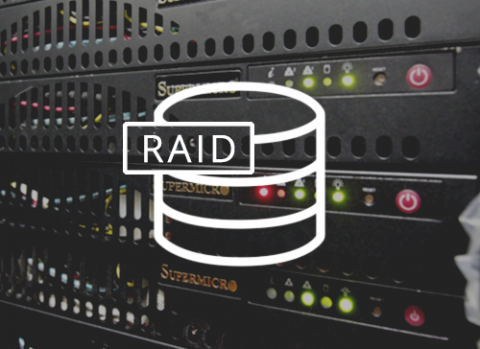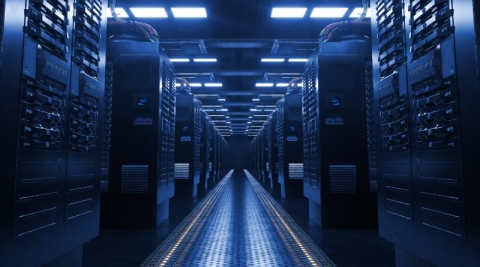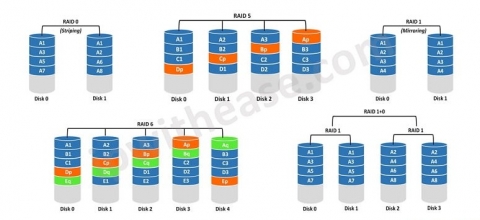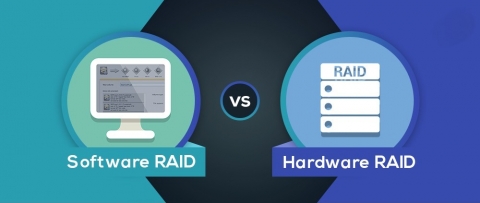A dedicated server with RAID provides you with the best web hosting solution.
It keeps your data secure with its formidable system. That makes it the most efficient kind of web hosting solution. A server is essential to host your website. And, you can rely on a dedicated server for that.
Different resources build your company website. Different multimedia files comprise those resources. Images and videos are the most important among those multimedia files. It also comes with different files like CSS, HTML, and JavaScript. And, you know how essential those files are for your company website, too.
Now, a dedicated server gives you the maximum storage capacity. This storage capacity helps you to save, manage, and recover your data. A dedicated server ensures the safety and security of those data.
Still, you can lose your data in a dedicated server due to several reasons. That might be hardware failure, cyberattacks, or data breaches. And data loss can make a significant impact on your company website.
RAID can be of significant help in this case.

RAID system gives you an extra edge to manage your dedicated server the best. It improves your dedicated server system with its functions.
This blog will guide you on how RAID array can help your dedicated server from data loss. You will also figure out the best RAID level to keep your dedicated server storage safe.
This blog will guide you through the following:
Types and Functions of RAID Levels
Why You Need RAID for Your Dedicated Server
Let’s get into the main discussion!
What Is a Dedicated Server?
A dedicated server serves as one of the major web hosting services. This gives you or your company an entire server to host your company website. This also provides you with all the server resources. Not only that, but you also get to have full access to every hardware of your server. These hardware are storage, bandwidth, CPU, and RAM. This also ensures peak performance, control, and customization.

You also get some of the best features with a dedicated server. These features make a dedicated server more advanced than other web hosting services. You get the best server performance with maximum security. This also helps you customize your server’s hardware and software settings. You can handle huge workloads to adjust your needs by configuring your dedicated server. This also gives you a guaranteed 99.9% or more uptime for your website. Full access means full control that you get with your dedicated server. That also means no other parties can use your dedicated server. That is not similar to other web hosting solutions like shared, VPS, or cloud hosting.
As you can see, you get the best facilities with a dedicated server. Your dedicated server gives you the utmost freedom to host your website.
What Is RAID?
RAID means Redundant Array of Independent or Inexpensive Disks. It works as a data storage virtualization technology. Through that, it combines many physical hard drives or SSDs into a single logical unit. This improves performance, data redundancy, or both in a dedicated server. This enhances reliability in its data storage. It allows you to add more drives. And that increases capacity in the computer systems with scalability. This helps your dedicated server to improve its performance.
RAID arrays build the RAID system. These RAID arrays distribute data across many disks. It duplicates your data from one hard drive to another. This is how it stores the data in your dedicated server. You also get data protection facilities along with that. But it does not work as a backup technology. Still, it enhances your server storage with its basic but essential functions.
Let’s take a look at how the RAID storage system functions in a dedicated server.
Functions of RAID
It works through three significant functions, and they are:
- Data Striping: This divides data into small blocks and spreads them across various drives.
- Data Mirroring: It duplicates data across various drives to create redundancy. It also stops data loss when a drive fails.
- Parity: This rebuilds and restores data in case of drive failure. It simplifies redundancy with less storage overhead than full mirroring.
Types and Functions of RAID Levels
RAID levels are the different structures that make a RAID system. There are different types of RAID array levels in a dedicated server. But RAID 0, 1, 5, 6, and 10 (1+0) are the most common levels.

Here are the functions of those levels:
- RAID 0: It works through striping. It stripes the data across two or more drives. It gives your dedicated server high performance for read and write operations. But it does not provide redundancy. That means the disk loses all data in case of drive failure.
- RAID 1: It works through mirroring. It duplicates the data on two or more drives. It provides high fault tolerance to the disks. This means the data remains undamaged on the other drive even if one drive fails. But it does not provide a complete storage facility. For example, two 1TB drives can only give you a 1TB usable storage.
- RAID 5: It works through striping with parity. It stripes both data and parity information across three or more drives. Here, parity allows restoring the lost data in case of drive failure. It gives you a proper balance of performance, redundancy, and storage efficiency. But it takes long rebuild times if one drive fails.
- RAID 6: It works through striping with double parity. So, it’s similar to RAID 5 but takes two sets of parity information. This allows up to two drives to fail without losing any data. This provides higher fault tolerance than RAID 5. But it needs more drives and has a higher parity calculation overhead.
- RAID 10 (1+0): This takes RAID 1 and RAID 0, and combines their functions, i.e. mirroring and striping. It stripes the data across pairs of mirrored drives. This, as a result, comes with superb performance and redundancy. But it is very expensive because it needs four drives, at least. Among those drives, only half of its total capacity is usable.
Software RAID and Hardware RAID
There are two types of RAID in practice. Those two RAID types are Software RAID and Hardware RAID. These two different RAID types implement RAID system. Here is a little overview of both these RAID systems:
Software RAID
Your dedicated server’s operating system manages this RAID storage system. It can also take specialized software to perform. It uses your server system’s CPU and memory to perform RAID functions.
It does not need any extra hardware or dedicated hardware RAID controllers to work. This makes it the most affordable option out there. But it can work across various types of hardware. It is also easy to configure because of the built-in tools in the operating system. Its RAID data storage setup is portable. It means that it allows moving the drives to another system with the same OS. You can maintain the RAID hard drive setup through that, too.
But it can reduce performance for other tasks because it uses the server system’s CPU and memory. It does not have many advanced features like hardware RAID. Its recovery is very complex because it uses the operating system of your dedicated server.

Hardware RAID
It uses a dedicated RAID controller that is a physical device. That’s how it manages RAID activities. These controllers are standalone cards. These cards come in installed in a dedicated server or built into its motherboard. That controller card or chip offloads the RAID storage functions without the operating system. It comes with a dedicated processing power for RAID system tasks that frees up system resources.
It provides faster server performance due to the controller. It also comes with battery-backed or flash-backed write caches. This protects your data during power failures. It replaces drives and rebuilds arrays in a faster and more reliable manner. It can also manage the boot drives. This allows your dedicated server system to boot straight from a RAID array.
But it’s very expensive because you have to buy a RAID controller. It depends on the hardware to configure, so its RAID setup is not portable. It has a complex initial setup. And data recovery gets more difficult in case of controller failure.
Why Need RAID for Your Dedicated Server
You need RAID for your dedicated server for the following reasons:
- Necessary Equipment: RAID system comes with the necessary arrangements to manage your dedicated server. A hardware RAID card or software RAID system takes control of the RAID array. This ensures smooth data distribution and recovery processes. Many dedicated servers also support hot-swapping procedures. This replaces failed drives without shutting down the server. It also provides your server with different monitoring tools. These tools inform you of drive health and possible failures. This is how it alerts you to take immediate maintenance.
- Data Redundancy and Fault Tolerance: These two features are the best facilities that the RAID system can provide your dedicated server. RAID storage system provides redundancy and fault tolerance through mirroring and parity. RAID 1, 5, and 6 are helpful in this case. This prevents data loss in your server guaranteeing seamless availability.
- Data Protection: All the RAID levels protect data through redundancy, performance, and storage capacity. Those levels ensure maximum data security for your dedicated server.
- Enhanced Performance: Some RAID array levels like RAID 0 and 10 improve your server performance by data striping. This allows simultaneous read/write operations across various devices. This eases the bigger workloads that need high-speed data access.
- Easy Recovery: RAID hard drive rebuilds the lost data in a new drive while replacing a failed one. And this doesn’t need manual restoration from backups.
Final Thoughts
This is all you need to know about how RAID is essential for your dedicated server.
This blog has given you a comprehensive detailed analysis to make up your mind.
RAID system enhances the performance of your dedicated server. That results in hosting your company website without any worries.
Thinking about buying the best dedicated servers? Choose Hosting Ultraso.
We provide you with top-notch dedicated servers equipped with different RAID types.
We have 119 data centers around the world where you can have the best dedicated servers.
Get our dedicated servers at affordable rates.
Make your business known to everyone with the fastest dedicated servers with maximum security.



